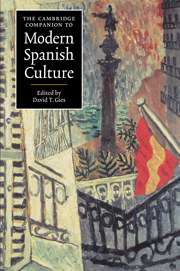Book contents
- Frontmatter
- Modern Spanish culture
- I Culture
- 1 What does it mean to study modern Spanish culture?
- 2 Spain as Castile
- 3 A cultural mapping of Catalonia
- 4 The Basque Country
- II Culture and history
- III Culture and prose
- IV Culture and poetry
- V Culture and theater
- VI Culture and the arts
- VII Media
- Index
- Series List
3 - A cultural mapping of Catalonia
from I - Culture
Published online by Cambridge University Press: 28 May 2006
- Frontmatter
- Modern Spanish culture
- I Culture
- 1 What does it mean to study modern Spanish culture?
- 2 Spain as Castile
- 3 A cultural mapping of Catalonia
- 4 The Basque Country
- II Culture and history
- III Culture and prose
- IV Culture and poetry
- V Culture and theater
- VI Culture and the arts
- VII Media
- Index
- Series List
Summary
The currently healthy state of Catalan language and culture seems far removed from the pessimism expressed by the poet Gabriel Ferrater in an article entitled, from a quotation by Paul Valéry “Paul Reboux”, “Madame se meurt” (“Madame is Dying”). In this article, published in Castilian in 1953 during the height of Franco's power and censorship, Ferrater pronounced Catalan culture dead. According to Ferrater, the Catalan language was also in mortal danger since it was being expressed culturally - by which he meant in the printed word - only in “high” literary texts, chiefly poetry. But spoken Catalan was in everyday use, and we can say, borrowing the words of the later writer and journalist Montserrat Roig, that Ferrater expressed in this article “a fatal divorce between the life of culture and science... and the collective or 'total' life of Catalan society.” Time proved Ferrater wrong. In 1976, two decades after his statement, and a mere two months after General Franco's death, Roig could affirm emphatically that “Madame vit encore” (“Madame is still alive”) (ibid.).
Roig's post-dictatorship optimism is in clear contrast to the pessimism of Ferrater, who committed suicide in 1972 and therefore was unable to see the changes in post-Franco Spain. In the post-Franco era, the hopeless divide that Ferrater saw between cultural (literary representation) and scientific life - which in Francoist Catalonia found expression exclusively in Spanish - and the everyday sphere (or “collective life” in Roig's words) in which Catalan was mostly used, came to seem perfectly negotiable. Montserrat Roig and many other representatives of Catalan culture in the years of political transition saw it as their collective task to bridge this divide.
- Type
- Chapter
- Information
- The Cambridge Companion to Modern Spanish Culture , pp. 37 - 53Publisher: Cambridge University PressPrint publication year: 1999
- 5
- Cited by



